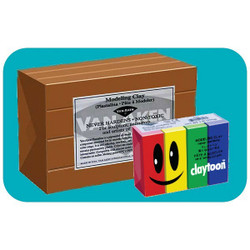
Modeling Clay
Sam Flax offers a variety of modeling clay for student, artist, professionals, and DIY projects. Modeling clay is a flexible material that can be molded in a variety of ways and may be very long-lasting, in the case of hardening clays. A number of materials can be used to make modeling clay and some products do not actually contain true clays, but are workable and behave like clay. These products are used by crafters, artists, and technical designers who may have reason to make clay models. They are also used in a type of animation known as Claymation.
Ceramic, oil, dough, paper, and polymers can all be used as a base for modeling clay. The most appropriate type of modeling clay to use can depend on the application. Broadly, they are divided into hardening and non-hardening clays. Non-hardening clays like those used in Claymation remain flexible so they can be adjusted. Hardening clays are designed to firm up to make a permanent project.
Some hardening clays air harden and will dry simply by being left out. If the user still wants to work on a project, she can mist it with liquid and bag it in plastic to prevent water loss. Other clays harden when exposed to heat, either in an oven for home crafts or a kiln. In the case of pottery clays, the clay undergoes a chemical transformation in the kiln and will change structure to create a very hard finished product.
Paper clays tend to be fast drying and lightweight. Polymer clays can be flexible or hardening and may be useful for a wide range of projects, while pottery clays are typically heavy. Dough clays are common for home crafts, especially with children who want to explore modeling. Some are nontoxic and designed specifically for kids. They also take dyes very well and can be blended to create different shades and tints of color.
- Product
- Qty in Cart
- Quantity
- Price
- Subtotal
-

Van Aken - Modeling Clay - 4.5 lbs. - White
Van Aiken
$18.99Quality, economically priced modeling clay. It never hardens, remains pliable and plastic and can be used time and time again. It is self-adhering, non-toxic and is used by sculptors, model makers, clay animators and artists of all ages. Streaking...332750$18.99 -

Van Aken - Modeling Clay - 1 lb. - Flesh
Van Aiken
$4.50Quality, economically priced modeling clay. It never hardens, remains pliable and plastic and can be used time and time again. It is self-adhering, non-toxic and is used by sculptors, model makers, clay animators and artists of all ages. Streaking...364338$4.50 -

Van Aken Modeling Clay, 1 lb., White
Van Aiken
$4.50Quality, economically priced modeling clay. It never hardens, remains pliable and plastic and can be used time and time again. It is self-adhering, non-toxic and is used by sculptors, model makers, clay animators and artists of all ages. Streaking may...300340$4.50 -
On Sale

Van Aken - Claytoon Clay Set - Primary- Blue, Green, Red, Yellow
Van Aiken
MSRP: $5.00Now: $4.00Was: $5.00These 1 lb. clay sets each contains four different 4 oz. colors of non-hardening, non-toxic modeling clay and an information booklet with instructions, helpful hints and project ideas. Each color is individually wrapped for freshness.307285MSRP: $5.00Now: $4.00Was: $5.00
